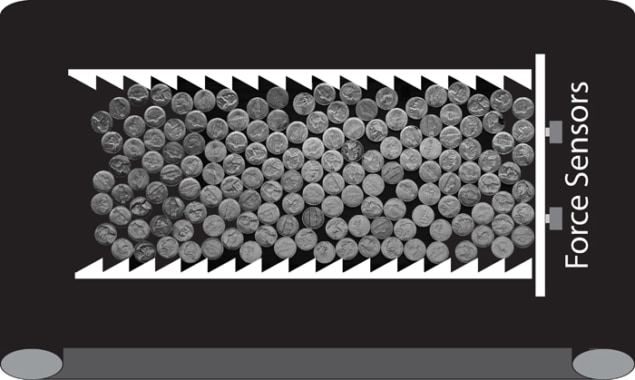
Friction in one part of a system can be reduced by boosting friction elsewhere. That is the curious and counterintuitive conclusion of Yasinul Karim and Eric Corwin of the University of Oregon in the US. The physicists made the discovery in a simple experiment involving coins moving on a walled conveyor belt. They showed that friction between the conveyor belt and the coins could completely remove the friction between the coins and the walls.
Karim and Corwin believe that their findings could be developed to improve how belts transport granular materials in industries as varied as coal mining and pharmaceutical manufacture. A scientist not involved in the work suggests that the strange phenomenon could have wider applicability in simulating the effects of gravity and even traffic management.
Friction carries the weight
In a container filled with a liquid, the downward force of the liquid on the base increases linearly with the height of the liquid. However, granular materials exhibit a phenomenon called the Janssen effect, where the friction between the material and the container allows the edges of the container to bear some of that weight. As the height of the material in the container rises, the increase in the force on the base becomes more gradual, until eventually adding more material to the container causes no change.
Now, the two Oregon physicists have turned the problem on its side, spreading out coins on a conveyor belt and confining them with two walls parallel to the direction of motion and a wall at the downstream end of the belt (see figure). “Gravity” is simulated by turning the conveyor belt on and pushing the coins towards the downstream wall. A sensor monitors the change in force on this wall as more coins are added to the belt.
Liquid currency
Surprisingly, the force measured increased linearly with the number of coins added, showing that, unlike in the vertical situation, the granular system behaves exactly like a liquid. Karim and Corwin propose that the friction between the belt and the coins causes the coins to vibrate. This vibration removes the friction between the coins and the sidewalls, thus preventing the sidewalls from bearing any forward force. All the force on the coins is therefore transferred directly to the downstream wall. Corwin offers an analogy: “If you take a brick, put it on a plank of wood and hold it at a certain angle, the brick won’t slide down because there’s friction between the brick and the wood. But if you bang on the wood or shake it, you will allow the brick to start sliding down.” Paradoxically, the presence of one sort of friction eliminates another.
The researchers found that if they added a sawtooth pattern to the walls that interlocked with the coins at the edges, then this macroscopic friction was not removed by vibration and they observed a type of Janssen effect, with the increase in downstream force levelling off as more coins were added.
Improved conveyor control
While the research is unlikely to be of much practical use – conveyor belts do not usually end at a wall – Karim and Corwin plan to look at dynamic situations in which items are moving on the belt. They hope this will provide insights into controlling and stopping objects in an efficient manner that does not apply excessive force and damage either the items or the belt.
John Wambaugh of the Environmental Protection Agency likes the paper’s demonstration of the Janssen effect in a model where gravity can be turned off. “If you’re on Earth, you’re always asking the question ‘What role does gravity play?’ but it’s very hard to switch gravity off and on,” he says. “Their system is an elegant way to simulate gravity in 2D.” Beyond this, he suggests that the ideas might be useful in other areas. “Traffic flow is basically a granular system,” he says. “Of course, gravity’s not operating in the same way, but you could certainly see how insights from a similar system might have a lot of impact on things people deal with every day.”
The research will be published in a forthcoming issue of Physical Review Letters.



